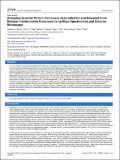Analyzing Dynamic Protein Complexes Assembled On and Released From Biolayer Interferometry Biosensor Using Mass Spectrometry and Electron Microscopy
Author(s)
Machen, Alexandra J.; O'Neil, Pierce T.; Pentelute, Bradley L.; Villar, Maria T.; Artigues, Antonio; Fisher, Mark T.; ... Show more Show less
DownloadPublished version (962.1Kb)
Terms of use
Metadata
Show full item recordAbstract
In vivo, proteins are often part of large macromolecular complexes where binding specificity and dynamics ultimately dictate functional outputs. In this work, the pre-endosomal anthrax toxin is assembled and transitioned into the endosomal complex. First, the N-terminal domain of a cysteine mutant lethal factor (LF[subscript N]) is attached to a biolayer interferometry (BLI) biosensor through disulfide coupling in an optimal orientation, allowing protective antigen (PA) prepore to bind (K[subscript d] 1 nM). The optimally oriented LF[subscript N]-PA[subscript prepore] complex then binds to soluble capillary morphogenic gene-2 (CMG2) cell surface receptor (K[subscript d] 170 pM), resulting in a representative anthrax pre-endosomal complex, stable at pH 7.5. This assembled complex is then subjected to acidification (pH 5.0) representative of the late endosome environment to transition the PA[subscript prepore] into the membrane inserted pore state. This PA[subscript pore] state results in a weakened binding between the CMG2 receptor and the LF[subscript N]-PA[subscript pore] and a substantial dissociation of CMG2 from the transition pore. The thio-attachment of LF[subscript N] to the biosensor surface is easily reversed by dithiothreitol. Reduction on the BLI biosensor surface releases the LF[subscript N]-PA[subscript prepore]-CMG2 ternary complex or the acid transitioned LF[subscript N]-PA[subscript pore] complexes into microliter volumes. Released complexes are then visualized and identified using electron microscopy and mass spectrometry. These experiments demonstrate how to monitor the kinetic assembly/disassembly of specific protein complexes using label-free BLI methodologies and evaluate the structure and identity of these BLI assembled complexes by electron microscopy and mass spectrometry, respectively, using easy-to-replicate sequential procedures.
Date issued
2018-08Department
Massachusetts Institute of Technology. Department of ChemistryPublisher
MyJove Corporation
Citation
Machen, Alexandra .J. et al. "Analyzing Dynamic Protein Complexes Assembled On and Released From Biolayer Interferometry Biosensor Using Mass Spectrometry and Electron Microscopy." Journal of Visualized Experiments 138 (2018): e57902 © 2018 Creative Commons Attribution-NonCommercial-NoDerivs 3.0 Unported License
Version: Final published version
ISSN
1940-087X